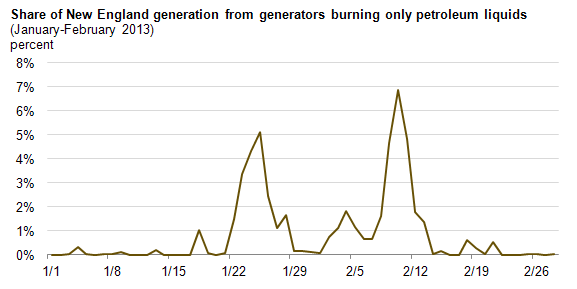
Winter natural gas price spikes in New England spur generation from other fuels

Note: New England includes Maine, New Hampshire, Vermont, Massachusetts, Connecticut, and Rhode Island.
A cold snap at the end of January 2013 caused an increase in natural gas demand for heating homes and businesses in New England, an area of the country with limited natural gas supply infrastructure. This demand surge taxed the region's natural gas pipeline capacity, causing a run-up in regional natural gas prices. The power market response to higher natural gas prices and tight supply was to reduce natural gas use for power generation and to increase generation from other fuels.
Electric power generation in New England was slightly lower (3%) in January 2013 compared to January 2012. However, generation from natural gas-fired units was down 18%, or 860,000 megawatthours. Natural gas for power generation became more expensive when New England spot market prices rose in January, in response to congestion on pipelines flowing natural gas into New England.
Petroleum is rarely used for power generation (only 0.3% of total annual generation in 2012 for New England) because it typically is more expensive than other fuels. This expense makes the increase in petroleum-fired generation between January 2012 and January 2013 notable. When power prices became high enough and natural gas scarce enough, the petroleum-fired generators operated more than usual. Data from the New England power system operator (ISO-NE, chart below) show that oil-fired generation rose on certain days in response to high wholesale power prices. Some of the decrease in natural gas-fired generation was also made up by coal and nuclear plants running at higher rates in January 2013 compared with the rates in January 2012.

Note: Data include generation from exclusively oil-fired generating capacity. Generators from units capable of switching between fuels, e.g., residual fuel oil and natural gas, are not included in this ISO-NE dataset.
Consumption of residual fuel oil for electric power generation in New England increased 380% between January 2012 and January 2013, with additional increases in distillate fuel oil and kerosene consumption. Overall, consumption of all petroleum liquids in New England for electricity generation during January 2013 was estimated to be 446,000 barrels, up from 127,000 barrels in January 2012.
Petroleum-fired generators often serve as peaking units—used principally during short-term spikes in demand for electricity—because of the relatively high cost of producing electricity from these units. In January 2013, electric demand was not particularly high, but petroleum generation rose anyway because of natural gas pipeline capacity constraints and high spot prices for natural gas. Petroleum generation helped fill the gap from lower natural gas-fired generator dispatch.
New England and New York have a significant amount of oil-fired and dual-fired generating capacity, allowing some generators in these markets to substitute petroleum for natural gas to produce electricity.
New England can also import and export electricity from and to Canada and New York; on average, it imports more electricity (largely hydropower from Canada) than it exports (mostly to the New York City area). Overall, net imports in New England were 50% higher during January 2013 than in January 2012. However, hourly interchange data from ISO-New England showed that during the cold snap in January, net imports of electricity were significantly below normal levels, reflecting high electricity demand in regions that typically sell excess power to New England.
EIA recently released detailed electric power generation data for January, covering the beginning of the cold snap in New England. These data are preliminary and based on a sample of power plants. The increased wholesale electric and natural gas prices, as well as the changing fuel consumption in the Northeast, were discussed in a recent edition of the Electricity Monthly Update.